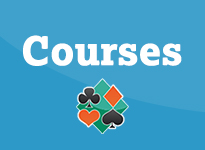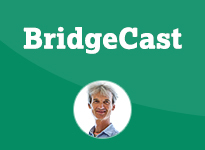
Book a Course
View all the latest courses going on at the bridge club and book yours now...Answers:
Answer #49
Three possible hands are given for South but only one is consistent with bidding (or indeed lack of!). Which one? What and when should the other hands have bid? Neither side is vulnerable
| North | East | South | West | |||
|
Pass Pass |
1 ♥ Pass |
Pass Pass |
1 ♣ 2 ♥ |
| Hand a) |
|
♠ J 9 7 3 2 ♥ 2 ♦ Q 9 7 3 ♣ A 4 2 |
| Hand b) |
|
♠ J 4 ♥ K Q 10 ♦ A 4 3 2 ♣ K J 9 4 |
| Hand c) |
|
♠ Q J 3 2 ♥ 8 2 ♦ A J 5 3 2 ♣ 8 2 |
Answer:
(b) is correct.
(b) is correct.
- When the opponents show a fit (yes, they might only have seven hearts if West has supported with three) and stop at a low level, you should be loath to let them play there. When they have a fit, normally your side have a fit; when the opponents stop at a low level, you side have fair values; if you have a poor hand, partner has a decent one (but was not quite able to bid). You are in the “cheat seat” (after pass – pass – ) and should protect.
- Only with Hand (b) should you pass – because your hand is far better suited to defence.
- With Hand (a), you should protect with 2♠ – you were right to keep quiet the first time.
- With Hand (c), you should protect with double (for take-out) – again you were right to keep quiet the first time. Note that on both occasions your partner will know you do not have a serious hand, or you’d have acted the first time. Your mission is primarily to push the opponents to the three-level, whereupon you (and partner – note) should almost always keep quiet and hope to defeat their contract by one trick.
Click here to return to quiz





